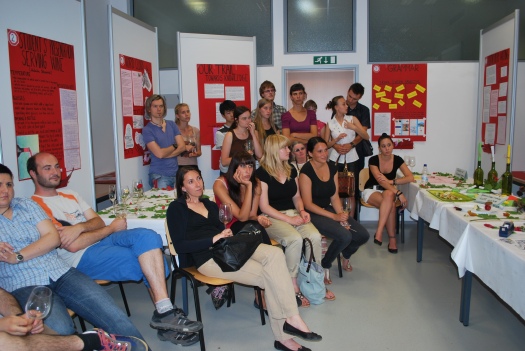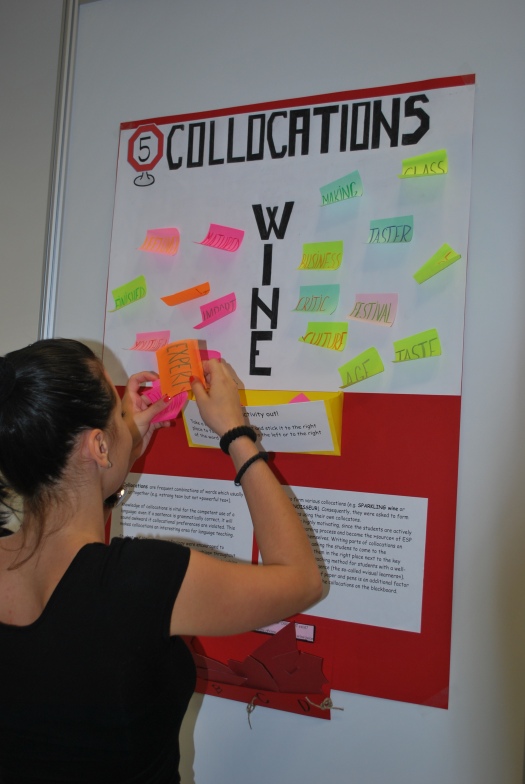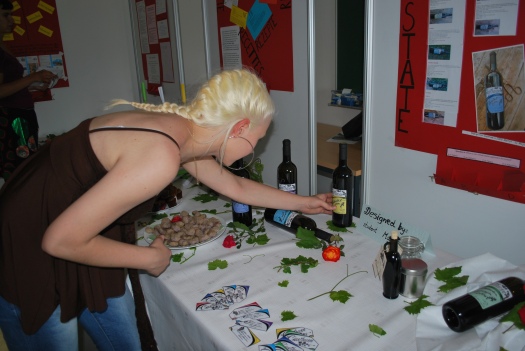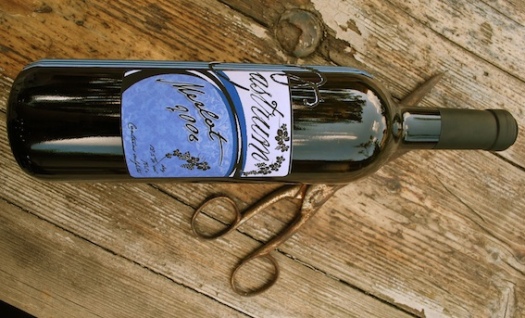Project Work as a Tool for Enhancing the Transfer of ESP Knowledge into Practice
Veronika Piccinini, Slovenia
Veronika Piccinini works as an Assistant for the English Language at the University of Nova Gorica (Slovenia), where she teaches general English and ESP at various study programmes related to humanities as well as natural sciences. She is particularly interested in the methodology of ELT. E-mail: veronika.piccinini@ung.si
Menu
Introduction
Aims of the project
Background
Implementation
Evaluation
Conclusions
References
In the 2010-2011 academic year, the ESP project »Our Trail towards Knowledge« was launched at the University of Nova Gorica, Slovenia. The main aim of the project was to encourage students to use their foreign language knowledge in practice, which would help them with their future jobs.
Most of the project activities referred to learning English for viticulture and enology. Therefore, most of the tasks were performed by undergraduate students of the study programme Viticulture and Enology, run by the School for Viticulture and Enology of the University of Nova Gorica. The two major project tasks were the co-organisation of the traditional Students’ Wine Festival at the University of Nova Gorica and the establishment of a virtual winery, run by students. Besides English, the following foreign languages were also included in the project activities:
- Slovene as a foreign language,
- Italian,
- German,
- French,
- Norwegian.
Project website: http://languageprojects.ung.si
The website of the virtual winery (The Castrum Estate):
http://castrum.pbworks.com/w/page/40448247/FrontPage
The main reason why I decided to carry out the project “Our Trail towards Knowledge” was that I had noticed the opportunities for our ESP students to use the acquired knowledge in practice had always been scarce. The University of Nova Gorica does have a well-developed system of transferring the students’ theoretical knowledge into practice, but it mainly concerns fields other than foreign languages. The system focuses on creating the opportunities for student placements in various companies and establishing links between scholars, science and, on the other hand, local industries. Prior to the introduction of my foreign language project, there had been no mechanisms to encourage the transfer of students’ foreign language knowledge into practice. At the same time I noticed that the students’ needs to use the acquired linguistic knowledge in practice were increasing. The most obvious and challenging situation has always been that of the students of Viticulture an Enology, since most of them run winemaking businesses together with their families (the Vipava Valley, where the School for Viticulture and Enology is located, is a famous winegrowing region). These students thus need English and other foreign languages on a daily basis to communicate with their customers and business partners.
Another reason for introducing changes in the teaching process was the need to raise the students’ motivation for learning ESP. At the beginning of each academic year, the common students’ perception of ESP is that ESP is strenuous and boring and the students feel “lost” when they have to use foreign language in practice. In this respect, Kovačević (2002) points out that people who use ESP have already learned the technical terms peculiar to their particular jobs and that what they do not know is how to say what they want to say when they use those technical terms. I therefore expected that the introduction of modern and creative ELT methods would increase the learners’ motivation and that taking this approach would enable moving from the conventional field of ‘English for Specific Purposes’ to ‘Communication for Specific Purposes’ and, as Brennan and van Naersen (1989) show, thus emphasize the broader academic/professional communication needs, with language as one of the tools of communication.
Last but not least, I also hoped that during various project stages useful ESP materials would be created, which could later be used to teach English for viticulture and enology – an ESP field which is so specific that virtually no ELT materials exist, or they might be extremely scarce. And yet one of the roles of the ESP practitioner is also to provide the materials for the course. Provision does not only mean choosing materials and making a suitable number of copies for the class: The teacher’s task also includes adapting material when published materials are unsuitable, or writing his/her own materials (Sierocka 2008).
The target audience taking part in the project activities comprised: 46 students of Viticulture and Enology and approx. 240 other participants – Slovene and foreign students of other study programmes, foreign employees at the university, visitors of the Students’ Wine Festival, other foreign language teachers, local wine producers and experts in the fields of enology and viticulture, as well as media representatives.
General aims:
- to raise the learners’ interest for learning foreign languages,
- to motivate the learners to learn ESP, EGP and other foreign languages,
- to increase the transfer of knowledge of languages into practice,
- to promote the use of modern and creative foreign language teaching methodologies,
- to promote the use of ICT in ELT,
- to encourage cooperation between ESP practitioners and content lecturers (experts in
viticulture and enology),
- to raise the level of intercultural understanding and communication across cultures,
- to present local traditions to foreigners and introduce the art of winemaking to them
through using English as a medium for successful communication.
Specific aims:
- to teach the students of Viticulture and Enology specific ESP vocabulary related to
their study field, as well as to teach them certain grammatical structures by using
modern and creative language teaching approaches,
- to develop the students’ writing skills, as they are expected to need them in their
future jobs (writing a CV, a job application, wine reviews etc.),
- to develop the students’ reading skills by using authentic materials in class (articles,
corpora, websites etc.),
- to develop the students’ speaking skills and raise their awareness of different
registers (this was practised through communicating with foreigners, analyses of
corpora material/audio-video materials),
- to provide foreign-language materials and services for foreign visitors of the
Students’ Wine Festival (presentations, posters, exhibitions),
- to teach students how to successfully prepare and deliver a presentation in a foreign
language,
- to organise activities promoting foreign languages and communication across
cultures,
- to establish a virtual winery (in this way the students get ESP practice and learn how
to use ICT),
- to encourage the cooperation between the students of Viticulture and Enology and
the students of other study programmes (Engineering and Management, Slovene
Studies, Cultural History, as well as foreign students of the University of Nova
Gorica),
- to produce new ESP teaching materials (a collection of exercises etc.) to be used at
the study programme Viticulture and Enology.
Project stages, activities and events
Stage 1 (September 2010): The project is introduced to the audience. 1st year students of Viticulture and Enology revise what they had previously learned during English classes at secondary schools (revision of EGP), they start acquiring ESP in the relevant field; students of the School of Humanities are also invited to participate and modern methodologies are applied to teaching various foreign languages at the University of Nova Gorica (also in the process of teaching Slovene as a foreign language).
Events: “Culinary afternoon” at the university (Slovene students present traditional Slovene dishes and wines to foreign students; they use English as a medium of communication), “Wine Tour” (Slovene students organise the visit of the Centre for Wine Research of the University of Nova Gorica, wine tasting events, a grape-picking event, a visit of the local winery – Slovene students offer translation services to foreign students)
Stage 2 (October 2010 – May 2011): The students acquire ESP knowledge and work on improving their communication skills. The students of other study programmes (Engineering Management, Slovene Studies and Cultural History) get involved and help the students of Viticulture and Enology prepare the materials for the foreign-language section of the Students’ Wine Festival. The students of Viticulture and Enology establish a “wiki” – a website of a virtual winery, the Castrum Estate.
Stage 3 (May 2011): Using the acquired linguistic knowledge in practice. The students of the School for Viticulture and Enology organise the foreign-language section of the Students’ Wine Festival 2011. They prepare and deliver oral presentations in English on various viticultural/enological topics (e.g. “The history of wine”, “Winegrowing regions”, “How to serve wine” etc.). They design and display posters presenting the project activities. The posters are designed in an innovative way – they not only present various enological topics, but also present the ELT methodologies which were used in class to teach them ESP. The posters are numbered and arranged in a specific way to form a “path” that the visitors of the festival follow. At each “stop”, the visitors can learn about a particular topic or methodology. What is more, the posters are interactive, as each of them displays a question which is to be answered by a visitor. The visitors participating in the game choose cardboard puzzle with correct answers and at the end of the “path” all the collected puzzle pieces are joined to form an image (the drawing showing wine being poured into a glass was also drawn by a student of Viticulture and Enology). The “path” metaphorically symbolizes the so-called “wine-trails” (tourist “routes” leading from one winery to another, often found in our winegrowing region). The word “trail” is also used metaphorically in the title of the project. At the wine festival, the Castrum Estate virtual winery was also presented and a major achievement was also the exhibition of wine bottle designs, business cards and the designs of other products of the Castrum Estate. The designs were made by a student of Engineering Management. The students exhibit their collections of poems in English and a collection of recipes in various foreign languages (Italian, French, German and Norwegian). The recipes contain wine as one of the ingredients. Foreign students are also invited to deliver oral presentations in English (presentations of their countries and their winegrowing traditions). Other activities at the Students’ Wine Festival are described below.
Events: Traditional Students’ Wine Festival, organised on 27th May 2011 (oral presentations of viticultural/enological topics in English, interactive posters in English, exhibitions of students’ collection of poems and recipes, presentation of the virtual winery, buffet with traditional dishes made with wine, wine tasting events, taking foreign students and staff to a local winery to learn about the winemaking process).
ELT methodologies used
According to experience in practice and on the basis of scientific findings it is evident that when teaching ESP, language teachers should not use the same approach that is used in teaching general English, because these two are apparently different in their goals and learning content (Tsao 2011). Taking this into account, I began searching for suitable methodologies to be used in class. I opted for a combination of various ESP and EGP methods and concentrated on the implementation of creative techniques in the teaching process. This was by no means easy as I had to take into account various obstacles – from the rather low level of the learners’ English language competence at the beginning of the academic year, the difficulty of the ESP field taught, the non-existence of appropriate ESP teaching materials etc. I also faced different logistic problems related to the organisation of the timetable and the organisation of the wine festival. I therefore agree with Pugliese (2010), who claims that teaching creatively implies, then, flexibility, a certain skill for improvisation – and that the teacher doesn’t merely ‘cover the material’ but leads the group on a path of discovery.
Below I am including the list of some of the creative ELT/ESP activities which were done in class. I have learnt many of these activities during my teacher training periods at Pilgrims.
Activities:
- creative teaching of ESP collocations (the teacher writes the chosen collocational node on the blackboard and gives the students pieces of papers containing the words – collocators; the students are asked to come to the blackboard and stick the word in the correct position to form a collocation);
- using ICT in ELT: creating a “wiki” website – a virtual winery (featuring descriptions of wines and other products, online wine shop etc.)
- creative poetry writing (by answering a set of unusual questions, the students come up with words which they later incorporate into a larger text and unintentionally form a poem; the original activity was presented to me by S. Farley, teacher trainer at Pilgrims, but I have adapted the activity to suit the needs of the students of Viticulture and Enology);
- working with authentic texts of unusual genres (the students collected and analysed recipes in English; they translated recipes into various foreign languages and Slovene, they prepared various dishes made with wine and served them at the wine festival);
- composing the descriptions of wines “for sale” in the students’ virtual winery (the students and I as an ESP practitioner had to work together with the content lecturers and other experts in enology in order to create precise sensory evaluations of each wine);
- introducing the elements of NLP in ELT practice (sample exercise: the students revise ESP vocabulary and develop their speaking skills by classifying the given words into various categories related to different senses, e.g. into columns “I see”, “I hear”, “I feel” etc.; later the students are asked to share their views with each other and discuss the differences);
- forming “word clouds” with the help of www.wordle.net and using the words from the clouds in a creative way (I have learned about the advantages of using www.wordle.net at the Pilgrims workshop held by H. Kryszewska and I immediately started using this application in class. I created word clouds with the texts which we would later read in class and asked the students to examine the words in the clouds and guess what the texts would be about. I also asked them to form collocations with the words from the clouds and later use them in a relevant context. The students also formed word clouds from the texts we had previously used in class and formed new collocations or looked for synonyms/antonyms among the words in each image.);
- introducing the “field work” type of practice (the students acted as interpreters, guides and presenters on various occasions; in this way they had the opportunity use English in order to communicate with foreigners).
According to my opinion, the project “Our Trail towards Knowledge” was a great success. We have received a lot of positive feedback from the students, foreigners at the University of Nova Gorica, university staff, experts in enology as well as general public – this was especially obvious at the main event, the Students' Wine Festival of the University of Nova Gorica. The students voluntarily dedicated a considerable amount of their free time to accomplish the project activities – to create a virtual winery, prepare various multilingual materials and interactive posters and to deliver oral presentations on enological topics in English. Moreover, the Castrum Estate’s website, the designs for wine/grape seed oil bottles, grape seed tea bags and business cards (all containing texts in English) designed by a student of Engineering and Management exceeded all our expectations and represented another way of transferring linguistic knowledge into practice. I also noticed that the students’ speaking skills had improved and that the students had no longer been afraid to use English in public or deliver a presentation in English. The most valuable feedback about the project came from the students themselves – they claimed they had enjoyed taking part in the project and agreed that such activities would definitely help them communicate in a foreign language in a successful way. Consequently, my future plans are to carry on with a number of project activities and even upgrade them. The project was also selected as one of the top seven Slovene projects at the 2011 national European Language Label contest, organised by the European Commission.
On the basis of the findings described in the Evaluation section I can claim that the introduction of creative ELT methods and innovative techniques of teaching ESP was a huge success and definitely raised the students’ motivation for learning ESP. As a result, the students’ English language skills improved considerably. The same holds true for their presentation skills and, to a certain extent, for their ICT skills. Armed with all this knowledge and higher self-confidence, the students undoubtedly have a chance of being more successful in their future professional careers.
Brennan, M. and M. van Naersen, (1989): Language and Content in ESP, in ELT Journal, Volume 43/3. Oxford: Oxford University Press
Kovačević, V., (2002) The difference between ESP and general English presentations, in IATEFL Slovenia – 9th Annual Conference. M. Belak, ed. Ljubljana: IATEFL, pp. 117–122
Pugliese, C., (2010) Delta Teacher Development: Being Creative: the Challenge of Change in the Classroom, Peaslake: Delta Publishing
Sierocka, H., (2008) The role of the ESP teacher,
www.jezykangielski.org/authenticmaterialinpractise.pdf (Accessed on July 5, 2011)
Tsao, C., (2011) English for Specific Purposes in the EFL Context: A Survey of Students and Faculty Perceptions, in Asian ESP Journal, Volume 7-2. Asian ESP Journal Press




Photo 1: Presentation of the project at the Students’ Wine Festival
Photo 2: Interactive poster – forming collocations
Photo 3: Student, author of the wine bottle designs, arranging the exhibition
Photo 4: Design for Castrum’s 2006 Merlot bottle
All photos by: Veronika Piccinini

Please check the Creative Methodology for the Classroom course at Pilgrims website.
Please check the CLIL General Methodology course at Pilgrims website.


|